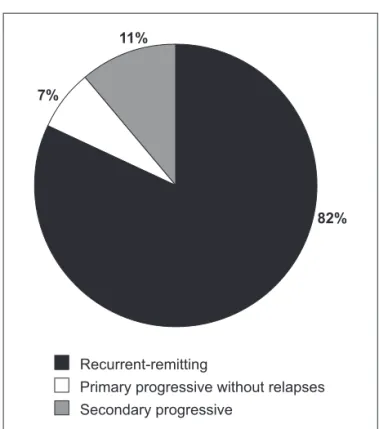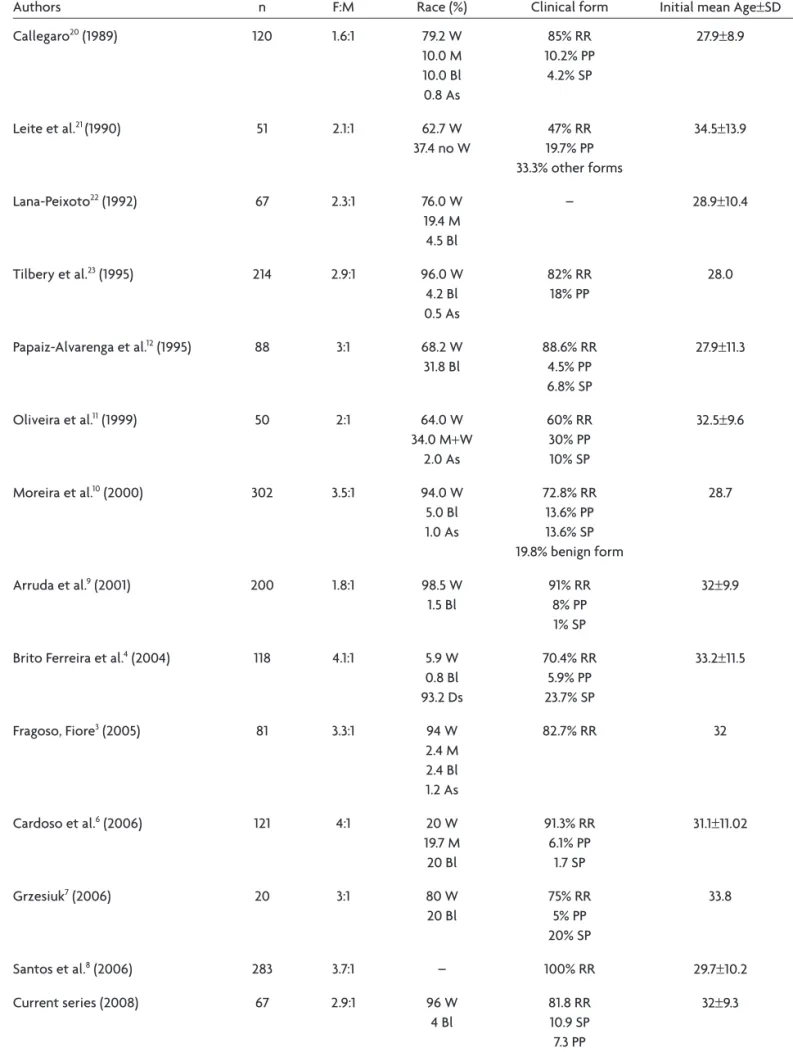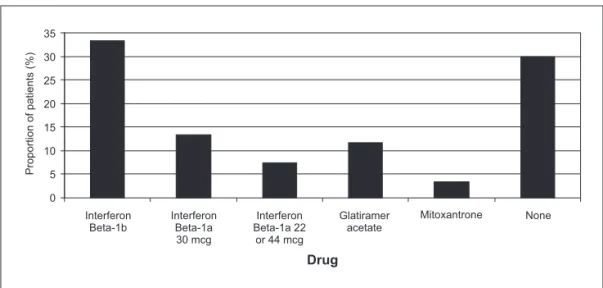Arq Neuropsiquiatr 2009;67(4):1071-1075
CliniCal Features oF Multiple
sClerosis in the south oF Brazil
A partial analysis
Alessandro Finkelsztejn
1, Rafael do Amaral Cristovam
2, Gisele Silva de Moraes
2,
Mariah Graziani de Souza Mello Lopes
2, Aline Vitali da Silva
2, Marcio Severo Garcia
2,
Caroline Miotto Menegat Cola
2, Carlos Eduardo Bastiani
2, Lísia Barros Ferreira
2,
Amanda Lucas da Costa
2, Silvete Maria Brandão Schneider
3, Thirzá Baptista Frison
4abstract – There are no published studies on the characteristics of multiple sclerosis (MS) patients from the south of Brazil. Objective: To identify the clinical features of a series of MS patients and to compare to other Brazilian series. Method: Retrospective study with 67 patients followed in The MS Reference Center - RS, Brazil during the year of 2008. We analyzed demographic and clinical data. Results: Most were women (74.6%), the general average age was 43.5 years old, and the general average EDSS score was 4.1. Of those patients, 81.8% had relapsing-remitting MS. Sexual dysfunction prevalence was 31.1% in men and 68.9% in women (p<0.01). We found a positive correlation (Spearman=0.444, p<0.05) between EDSS and depressive symptoms. Conclusion: This study showed a very similar sample compared to other states of Brazil. Moreover, there was found a high prevalence of sexual dysfunction and a straight relation between EDSS and depressive symptoms.
KEy WORDS: multiple sclerosis, epidemiology, depressive symptoms, sexual dysfunctions.
Características clínicas da esclerose múltipla no sul do Brasil: uma análise parcial
resumo – Não há dados publicados sobre as características clínicas da esclerose múltipla (EM) no estado do Rio Grande do Sul (RS). Objetivo: Identificar e comparar as características clínicas de uma série de pacientes com EM no RS com as de outras séries nacionais. Método: Foram coletados e avaliados dados demográficos e clínicos de 67 pacientes atendidos em nosso centro. Resultados: Houve predomínio de mulheres (74,6%), idade média geral foi de 43,5 anos e EDSS médio de 4,1. O tipo surto-remissão correpondeu a 81,8%. A prevalência de disfunção sexual foi de 31,1% nos homens e 68,9% nas mulheres (p<0,01). Encontrou-se correlação de 0,444 (p<0,05) entre depressão e EDSS. Conclusão: Este estudo demonstrou uma amostra semelhante às demais amostras brasileiras, apresentando, adicionalmente, elevada prevalência de sintomas sexuais e a estreita associação entre depressão e o grau de incapacidade.
PALAVRAS-CHAVE: esclerose múltipla, epidemiologia, sintomas depressivos, disfunção sexual.
Hospital de Clínicas de Porto Alegre, Porto Alegre RS, Brazil: 1Neurologist, Master in Epidemiology, Federal University of The State of Rio Grande do
Sul; 2Medical Student, Federal University of The State of Rio Grande do Sul; 3Nurse, Hospital de Clinicas de Porto Alegre; 4Psychologist, Master in
Neuroscience.
Received 2 April 2009, received in inal form 26 June 2009. Accepted 3 August 2009.
Dr. Alessandro Finkelsztejn – Rua Mostardeiro 5 / 1002 - 90430-001 Porto Alegre RS - Brasil. E-mail: ainkels@portoweb.com.br
Multiple sclerosis (MS) is an immunomediated neuro-logical disease, affecting people in the early adulthood. It is the most common cause of acquired physical disability in many countries of North America and Europe1. In Brazil, the prevalence of MS is approximately 15 cases/100.000 habitants in the southeastern region2,3,however, since the Brazilian large territorial extension, it is considered a
Re-lapsing-remitting MS is the most common form, repre-senting 80–85% of cases1. The geographic factor is a heavy determinant of disease distribution because colder coun-tries display the highest prevalence rates of MS worldwide. Epidemiologic studies in many Brazilian regions have been published2-12 presenting demographic and clinical characteristics of treated patients at different clinics and hospitals. Nevertheless, there are no published data on MS patients in the state of Rio Grande do Sul. There are only indirect data on MS prevalence in this region, as demon-strated in a recent thesis that estimates the number of hos-pital admissions for MS relapse since 2002 through 2006. This study demonstrated that the state of Rio Grande do Sul was the second one considering the absolute num-bers of hospital admissions for the treatment of MS13.
The Neurology Service from Hospital de Clínicas de Porto Alegre (HCPA) has a complete medical aid for MS patients: neurologists, nurses, neuropsychologists, psychi-atrists, emergency room consultation, day-hospital, and inpatient admissions. The Neurology Service from HCPA has joined to the Health Public Department of the State of Rio Grande do Sul since the year of 2006, with the ob-jective of evaluating all prescriptions of interferon beta or glatiramer acetate from our State. Since that time, outpa-tient assistance of MS paoutpa-tients has been reorganized.
We started a new registration system for these pa-tients, collecting clinical and demographic data in a fast-er way, and yet have gathfast-ered data from 50% of patients. Nevertheless, we decided to analyze the data already col-lected, comparing them with those of other published Brazilian series.
Method
This is a retrospective study of 67 patients attending our Center, during the year of 2007 and 2008. All patients were
di-agnosed by the Revised McDonald Criteria14 and clinical and
demographic data have been collected by the authors during consultation. The database created was analyzed for that pe-riod. The variables analyzed were age, gender, race, age of dis-ease onset, type of evolution according to Lublin classiication4, Expanded Disability Status Scale (EDSS)15, amount of years suf-fering the disease, treatment with interferons, glatiramer ace-tate or other medications and its side effects, Beck depression
scale16, and urinary dysfunction symptoms through a
question-naire comprising fundamental questions regarding lower urinary tract symptoms17.
The research project has been approved by the HCPA Re-search Ethical Committee. As were the authors who collected the data from medical registers, they signed the informed con-sent, respecting privacy and anonymity of patients.
Data have been analyzed through SPSS version 11.5 software, by calculating continuous variables averages, standard devia-tion (SD) and also categorical variables propordevia-tions. T-test was
used when appropriate, likewise Pearson or Spearman correla-tion test.
results
The average age of our sample was 43.5 years (SD 11.2). The average time since the irst symptoms of disease was 11.5 years (SD 6.7). The average EDSS was 4.1 (SD 2.4).The proportion between women and men was 2:1 (50 women and 17 men). Demographic and clinical characteristics data are summarized in Table 1 and compared to other Brazil-ian series Table 2. The Fig 1 shows the distribution of MS evolutive forms in our sample.
Distribution of the different prescribed drugs is sum-marized in Fig 2. There are 5 main drugs of irst choice for the treatment of MS: interferon beta 1A 30 micrograms, interferon beta 1A 22 micrograms, interferon beta 1A 44 micrograms, interferon beta 1B 300 micrograms and
glat-Table 1. Clinical and demographic characteristics of MS patients in the South of Brazil.
Sample characteristics Mean±SD*
Age (years) 43.5±11.2
Age of symptoms beggining (years) 32±9.3
Age at diagnosis (years) 35.5±10.6
Time of disease (years) 11.5±6.7
EDSS 4.1±2.4
Beck depression scale 16.3±8.8
*SD: standard deviation.
Secondary progressive
Primary progressive without relapses Recurrent-remitting
82% 11%
7%
Table 2. Results of epidemiologic studies about MS in Brazil.
Authors n F:M Race (%) Clinical form Initial mean Age±SD
Callegaro20 (1989) 120 1.6:1 79.2 W
10.0 M 10.0 Bl 0.8 As
85% RR 10.2% PP
4.2% SP
27.9±8.9
Leite et al.21 (1990) 51 2.1:1 62.7 W
37.4 no W
47% RR 19.7% PP 33.3% other forms
34.5±13.9
Lana-Peixoto22 (1992) 67 2.3:1 76.0 W
19.4 M 4.5 Bl
– 28.9±10.4
Tilbery et al.23 (1995) 214 2.9:1 96.0 W
4.2 Bl 0.5 As
82% RR 18% PP
28.0
Papaiz-Alvarenga et al.12 (1995) 88 3:1 68.2 W
31.8 Bl
88.6% RR 4.5% PP 6.8% SP
27.9±11.3
Oliveira et al.11 (1999) 50 2:1 64.0 W
34.0 M+W
2.0 As
60% RR 30% PP 10% SP
32.5±9.6
Moreira et al.10 (2000) 302 3.5:1 94.0 W
5.0 Bl 1.0 As
72.8% RR 13.6% PP 13.6% SP 19.8% benign form
28.7
Arruda et al.9 (2001) 200 1.8:1 98.5 W
1.5 Bl
91% RR 8% PP 1% SP
32±9.9
Brito Ferreira et al.4 (2004) 118 4.1:1 5.9 W
0.8 Bl 93.2 Ds
70.4% RR 5.9% PP 23.7% SP
33.2±11.5
Fragoso, Fiore3 (2005) 81 3.3:1 94 W
2.4 M 2.4 Bl 1.2 As
82.7% RR 32
Cardoso et al.6 (2006) 121 4:1 20 W
19.7 M 20 Bl
91.3% RR 6.1% PP
1.7 SP
31.1±11.02
Grzesiuk7 (2006) 20 3:1 80 W
20 Bl
75% RR 5% PP 20% SP
33.8
Santos et al.8 (2006) 283 3.7:1 – 100% RR 29.7±10.2
Current series (2008) 67 2.9:1 96 W
4 Bl
81.8 RR 10.9 SP 7.3 PP
32±9.3
iramer acetate 20 mg. In cases of treatment for second-ary progressive MS, Mitoxantrone was used. In our sam-ple, there were 2 patients treated with this drug, since they met the criteria for this evolution form.
Among patients using interferon or glatiramer acetate, 38% related some adverse events (AE). Among men, 33% had headache and 17% had transitory elevation of liver en-zymes. Among women, the AE were 15.8% for lu symp-toms, 15.8% for pain at site of injection, 10.5% for head-ache, 10.5% for fever, and 5.3% for generalized body pain. The general prevalence of urinary dysfunction in our sample was 79% but not signiicantly different beetwen men and women (50% versus 80%, p=0.09, NS). In our cen-ter is routine to ask patients whether they have any uri-nary symptom. We considered that patients had uriuri-nary dysfunction when complained urgency, frequency, dysu-ria, retention, incontinence, whether they used any form of continence protection and, if they did, the reason: (1) as a precaution; (2) the presence of urine leakage regular-ly between urinations.
Sexual dysfunction was signiicantly higher in women than in men (68.9% versus 31.1%, p<0.05). We found a pos-itive correlation (Spearman coeficient=0.444, p<0.05) be-tween Beck depression score and EDSS score, which didn’t occur with other clinical variables. When testing this cor-relation independently by gender we didn’t ind a signif-icant difference.
disCussion
The results presented in this paper were calculated by analyzing demographic and clinical data from a Brazilian south case series. We chose to analyze traditional data such as age, gender and evolutive patterns of MS relat-ing them to the presence of depressive symptoms, sexual dysfunction, urinary disorders and adverse reactions from immunomodulators. We decided to analyze all of those
together in order to best study our sample. This study is innovative, as it is the irst national one studying all this data together, and as it is the irst to be carried out in the state of Rio Grande do Sul.
The average age of the onset of disease was 32 years (±9.3). The distribution of the clinical evolution forms were calculated: relapsing/remitting 81.8%, secondary progressive 10.9% and primary progressive without any re-lapse 7.3%. These results are similar to other national data. The F:M (women to men ratio) was 2.9:1, like the southern and southeastern Brazilian regions.
The average EDSS score was 4.1 (SD 2.4) which means that our sample has a large physical disability. The average disease duration time was 11.5 years (SD 6.7).
High Beck scores (average of 16.3, SD 8.8) means that our sample has moderate depressive symptoms, when compared to the population reference values18. This rate should alert physicians to ask for depression symptoms and to refer to a psychiatric evaluation, whenever need-ed. This diagnosis deserves much attention because the improvement of this condition contributes to a better quality of life.
The high proportion of patients with urinary dysfunc-tion shows that we cannot underestimate such symp-toms. We concluded that it is of extreme importance an anamnesis directed to the search of urinary dysfunction symptoms, and if those are positive, urological evaluation from a specialist is suggested. According to literature, the prevalence of neurogenic bladder is high in those patients and the treatment of this complication has the possibili-ty of favorable results, and several options of therapy are available19.However, in our study, we didn’t use a validat-ed questionnaire for the Brazilian population. There are some questionnaires for the detection of lower urinary tract symptoms, but most are complex and dificult to apply. It is necessary that short validated questionnaires Interferon
Beta-1b
Proportion of patients (%
)
Glatiramer acetate
Mitoxantrone None Interferon
Beta-1a 30 mcg
Interferon Beta-1a 22
or 44 mcg 35
30
25
20
15
10
5
0
in Portuguese be constructed to study MS patients in a more effective way. On the other hand, when considering sexual dysfunction, it is well-known that answers might depend on several variables and it could be necessary a skilled team to deal with these symptoms. Our approach should be considered as a simple screening, not excusing patients from a complete urologic or gynecologic con-sultation. And besides, since we know that there can be some important differences between men and women, we didn’t perform a complete analysis in this way since our sample was a partial one, and a complete analysis will begin soon.
There were important limitations when carrying out this study, since data were not prospectively collected and not aimed for the ends of this study. These limitations are inherent to any retrospective study. However after collecting and analyzing data from all patients assisted at our hospital, we plan to carry out a prospective and lon-gitudinal study in order to follow a real cohort.
It is important to point out that other important lim-itations are when comparing our sample to other Brazil-ian ones. For instance, there were differences in the data collected and in the methodology applied for gathering them in those series. The comparisons performed in our study aim to stimulate the Brazilian researchers in the MS ield to gather new data using a more uniied way. This will serve to enhance our knowledge on MS in our country.
In conclusion, our study analyzed demographic and clinical data, in order to have a better knowledge of MS patients in the state of Rio Grande do Sul, providing more comparable data to other national samples. It also pre-sented important data on urinary and sexual symptoms which are not routinely asked in many centers. Our study demonstrated a significant level of physical disability and depressive symptoms. It does not aim to be a study of broad external validity as long as data were collected from a convenience sample and in a retrospective basis. Larger studies should be done to better understand those symptoms in Brazilian MS patients, as well as uniied ones in a national basis.
reFerenCes
1. Noseworthy JH, Lucchinetti C, Rodriguez, Weinshenker M, Brian G. Medical progress: multiple sclerosis. N Engl J Med 2000;343:938-952. 2. Callegaro D, Goldbaum M, Morais L, et al. The prevalence os multiple
sclerosis in the city of São Paulo, Brazil, 1997. Acta Neurol Scand 2001; 104:208-213.
3. Fragoso YD, Fiore APP. Description and characteristics of 81 patients attending the reference center for multiple sclerosis of the coastal re-gion of São Paulo, Brazil. Arq Neuropsiquiatr 2005;63:741-744. 4. Ferreira MLB, Machado MIM, Vilela ML, et al. Epidemiology of 118
cas-es of multiple sclerosis after 15 years of follow-up on the reference cen-ter of Hospital da Restauração, Recife, Pernambuco, Brazil. Arq Neu-ropsiquiatr 2004;62:1027-1032.
5. Lublin FD, Reingold SC. Deining the clinical course of multiple scle -rosis: results of an international survey. Neurology 1996;46:907-911. 6. Cardoso E, Fukuda T, Pereira J, et al. Clinical and epidemiological
pro-ile of multiple sclerosis in a reference center in the State of Bahia, Bra -zil. Arq Neuropsiquiatr 2006;64:727-730.
7. Grzesiuk AK. Clinical and epidemiologic characteristics of 20 patients with multiple sclerosis in Cuiabá, Mato Grosso, Brazil. Arq Neurop-siquiatr 2006;64:635-638.
8. Santos EC, Yokota M, Dias NFR. Multiple sclerosis: study of patients with relapsing-remitting form registered at Minas Gerais Secretary State for Health. Arq Neuropsiquiatr 2007;65:885-888.
9. Arruda WO, Scola RH, Teive HAG, Werneck LC. Multiple sclerosis: re-port on 200 cases from Curitiba, southern Brazil and comparison with other Brazilian series. Arq Neuropsiquiatr 2001;59:165-170.
10. Moreira MA, Felipe E, Mendes MF, Tilbery CP. Multiple sclerosis: de-scriptive study of clinical forms in 302 cases. Arq Neuropsiquiatr 2000; 58:460-466.
11. Oliveira EML, Annes M, Oliveira ASB, Gabbai AA. Multiple sclerosis: clinical survey of 50 patients followed at the Department of Neurolo-gy UNIFESP-EPM. Arq Neuropsiquiatr 1999;57:51-55.
12. Papais-Alvarenga RM, Santos CMM, Abreu JS. Esclerose múltipla:
per-il clínico e evolutivo no município do Rio de Janeiro. Rev Bras Neurol
1995;31:75-87.
13. Finkelsztejn A. Tratamento do surto de esclerose múltipla em Hospi-tal-Dia: estudo de custo-minimização. (Dissertação de Mestrado). Uni-versidade Federal do Rio Grande do Sul. Porto Alegre, 2007. 14. Polman CH, Reingold SC, Edan G, et al. Diagnostic criteria for
multi-ple sclerosis: 2005 revisions to the “McDonald Criteria”. Ann Neurol 2005;58:840-846.
15. Kurtzke JF. Rating neurologic impairment in multiple sclerosis: an ex-panded disability status scale (EDSS). Neurology 1983;33:1444-1452. 16. Gorenstein C, Andrade L. Validation of a Portuguese version of the
Beck Depression Inventory and the State-Trait Anxiety Inventory in Brazilian subjects. Braz J Med Biol Res 1996;29:453-457.
17. Betts CD, D’Mellow MT, Fowler CJ. Urinary symptoms and the neuro-logical features of bladder dysfunction in multiple sclerosis. J Neurol, Neurosurg Psychiatry 1993;56:245-250.
18. Feinstein A, Feinstein K. Depression associated with multiple sclero-sis. Looking beyond diagnosis to symptom expression. J Affect Disord 2001;66:193-198.
19. de Sèze M, Rufion A, Denys P, Joseph PA, Perrouin-Verbe B. GENULF. The neurogenic bladder in multiple sclerosis: review of the literature and proposal of management guidelines. Mult Scler 2007;13:915-928.
20. Callegaro D. Contribuição ao estudo clínico evolutivo da esclerose múl -tipla: análise de 120 pacientes. Tese de Doutorado, FMUSP 1989. 21. Leite ACCB, Andrade C, Novis S. Esclerose múltipla no Rio de Janeiro:
apresentação clínica em 51 casos. Arq Neuropsiquiatr 1990;48(Suppl): S66.
22. Lana-Peixoto M, Lana-Peixoto MIV. Is multiple sclerosis in Brazil and Asia alike? Arq Neuropsiquiatr 1992;50:119-125.
23. Tilbery CP, Felipe E, Baldauf CM, Peres MFP. Esclerose múltipla: análise


